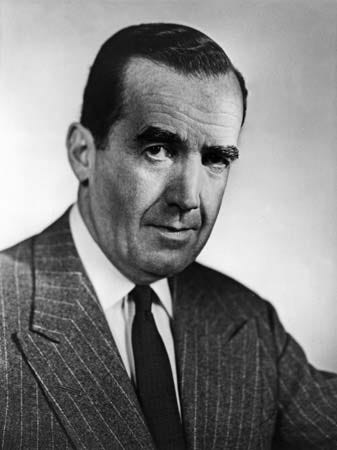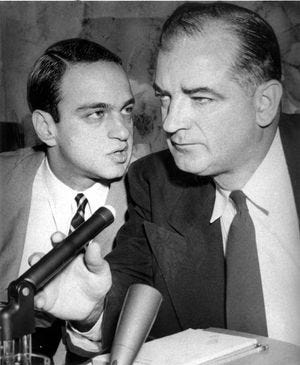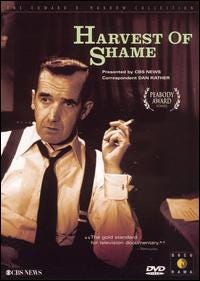Edward R. Murrow, 1961 (US Information Agency, public domain)
(Yes, there’s spoilers, but there’s so much more.)
No surprise that George Clooney chose to reprise his 2005 docudrama “Good Night, and Good Luck” as a stage play in 2025, whose July 7th Broadway performance was simulcast live on CNN and MAX. As relevant as the film version of Edward R. Murrow’s 1954 confrontation with Senator Joseph McCarthy had been to President George W. Bush’s fraudulently justified and disastrously waged Iraq War (2003-2011), the stage/TV revival is even more pertinent to Donald Trump’s war on democracy.
“Good night, and good luck,” Murrow’s signature signoff on his Hear It Now radio and See It Now television news broadcasts of the early 1950s, was inspired in World War II while he was reporting live from London during the Blitz. Londoners had begun using this phrase as a farewell, knowing that due to the night-time Nazi bombing, they might not see each other in the morning. Princess Elizabeth also chose the commoners’ farewell as a signoff for a radio broadcast during the Blitz.[1]
The catchphrase peppers both the movie and stage versions of Good Night, and Good Luck, which Clooney co-wrote (with Grant Heslov), directed, and stars in—in the film as Murrow’s co-producer Fred Friendly and in the play as Murrow himself (David Strathairn plays Murrow in the film).
But the words that resonate most strongly with our current predicament are those quoted by Clooney and Strathairn verbatim from Murrow’s on-camera monologues, and those uttered by McCarthy himself in his televised rebuttal to Murrow and by Air Force Reserve Lieutenant Milo Radulovich in a See It Now investigative report.
Radulovich had been discharged by the Air Force as a security risk based on allegations that his sister and father, a Yugoslav immigrant, were communist sympathizers (re today’s persecution of those who expresses sympathy for the Palestinian cause—which happens to include the majority of the American people, was the official US position pre-Trump 2.0, and has long been that of the international community).[2]
The main action of both film and play starts with the Radulovich report—already a bold move at a time when the McCarthy-inflamed Red Scare (re today’s Immigrant Scare) was at a fever pitch. But Radulovich makes an effective on-camera protagonist, decrying the damage to himself and his relatives, and predicting that if the judgment against him is “let stand, I see a chain reaction that has no end to anybody, for anybody” (re today’s ICE raids ensnaring not only undocumented immigrants with no criminal record but also legal immigrants and even American citizens.)[3]
The military’s case is further undermined by their determination that Radulovich himself is a loyal American (re the above). And worse, because the evidence against his relatives is contained in a sealed envelope that neither he nor his attorney were allowed to see (re the flouting of due process that federal courts have condemned in recent deportation cases). The clincher, however, is the threadbare case’s exposure on a popular and respected national news program, which proves the tipping point in Radulovich’s reinstatement one month after the See It Now report (re, one hopes, the effect media coverage of the outrageous ICE raids will have on today’s electorate).
But seeing justice served comes at a price, literally, for Murrow and Friendly.
Prior to the Radulovich report, they’d butted heads, in the play with CBS head William Paley (Paul Gross) and in the film with his lackey Sig Mickelson (Jeff Daniels). The issue was the conflict inherent to the corporate sponsorship of broadcast TV at the time (re today’s media beholden-ness to Trump: as in Disney-ABC’s and Paramount-CBS’s capitulating on his defamation suits against their news shows This Week and 60 Minutes, respectively).
Paley/Mickelson’s particular bone to pick on the Radulovich report is its affront to See It Now’s prime sponsor, Alcoa, which “happens to have contracts with the military” (re today’s corporations kowtowing to Trump for fear of losing their government contracts or grants) And not even Murrow’s memorable rejoinder—“I simply cannot accept that there are on every story two equal and logical sides to an argument”—can prevent him and Friendly from having to fork over the $3,000 ($35,000 today) for the ads on the Radulovich broadcast that Alcoa and CBS refuse to pay.[4]
Undeterred, however, and emboldened by their slap at McCarthyism, Murrow and Friendly decide to take the senator head on. Their method is to hoist the bullying demagogue (re You Know Who) on his own petard, with clips of two of his Senate investigations: one of Annie Lee Moss, a clerk at the Pentagon accused of being a security risk; and another of Reed Harris, a government official and former Columbia University grad student who’d been suspended for his liberal political views.
McCarthy plays into their hand with Moss by rudely leaving her hearing before its completion, while the Harris hearing reveals the senator’s penchant for lying (re You Know Who in spades). McCarthy’s most glaring falsehood was claiming that the ACLU, which had supported Harris in the suspension case, was listed as a subversive front by the attorney general. This was not only unfounded, but the ACLU has received letters of commendation from presidents Truman and Eisenhower and General Douglas McArthur.
Murrow could have gone further had he known at the time the full extent of McCarthy’s gross exaggerations about the number of Reds in the government (re Trump’s millions of immigrant murderers and rapists that don’t exist).[5] But Murrow’s closing See It Now commentary, besides delivering a knockout punch to McCarthy, is a crowning moment in the history of American television and advocacy journalism that well deserves the near-complete excerpt that follows:
“No one familiar with the history of this country can deny that congressional committees are useful. It is necessary to investigate before legislating. But the line between investigating and persecuting is a fine one and the junior senator from Wisconsin has stepped over it repeatedly. We must not confuse dissent with disloyalty. We must remember always that accusation is not proof and that conviction depends on evidence and due process of law.
“We will not walk in fear, one of another. We will not be driven by fear if we dig deep into our history and our doctrine and remember that we are not descended from fearful men, who feared to write, to associate, to speak, and to defend the causes that were for the moment unpopular. This is no time for men who oppose Senator McCarthy’s methods to keep silent, or for those who approve. We can deny our heritage and our history, but we cannot escape responsibility for the results. We proclaim ourselves, as indeed we are, the defenders of freedom wherever it continues to exist in the world, but we cannot defend freedom abroad by deserting it at home.
“The actions of the senator from Wisconsin have caused alarm and dismay amongst our allies and given considerable comfort to our enemies. And whose fault is that? Not really his. He didn’t create the situation of fear, he merely exploited it, and rather successfully. Casius [in Shakespeare’s Julius Caesar] was right: ‘The fault, dear Brutus, is not in our stars, but in ourselves.’”[6]
McCarthy’s rebuttal a few weeks later, rife, as usual, with bald-faced lies, only sets himself up for another pummeling by Murrow. More importantly, the whole exercise has an impact similar to that of the Radulovich report, when a month after the See It Now report on McCarthy in March 1954, the Senate launches its Army-McCarthy hearings in April, eventually leading to his censure by the Senate later that year.
Attorney Roy Cohn advising Senator McCarthy during the Army-McCarthy hearings (https://www.britannica.com/biography/Roy-Cohn).
Historical events are understandably compressed for dramatic effect in both the film and stage versions of Good Night, and Good Luck. But in one instance the timeline is skewed in a way that unfortunately does a disservice to See It Now and to CBS head Bill Paley. In both docudramas, directly after the historic McCarthy broadcasts, Paley demotes See It Now from its previous weekly primetime slot to 5 shows a year on Sunday afternoon, thereby neatly drawing an ironic parallel with the censured McCarthy’s staying in the Senate but being forced to sit in the rear of the chamber.
In reality, while McCarthy was indeed punished in this manner, See It Now not only kept its regular primetime slot through the 1953-54 season but through the 1954-55 season as well, winning several Emmys over that period and a special one for Murrow’s takedown of McCarthy! Only thereafter was the show sent out to pasture for its remaining three-year run.[7]
And even then, Murrow and Friendly did not go gentle into that good night. In their hard-hitting investigative series CBS Reports (1959-71, and beyond), they created another milestone in American television and affected history once again, with 1960’s Harvest of Shame. An-depth exposé of the plight of the country’s migrant farm workers, this Peabody-winning documentary spurred Congress to investigate farm worker conditions and contributed to the formation by Dolores Huerta and Cesar Chavez of the National Farm Workers Association in 1962, forerunner of the United Farm Workers union.[8]
(Fair Use)
Murrow was appointed head of the United States Information Agency by John F. Kennedy in 1961. He died in 1965 at age 57 of lung cancer—no great surprise for the inveterate smoker, on screen and off.
Joe McCarthy, an inveterate tippler, died in 1957 at age 48.[9]
Roy Cohn, McCarthy’s attorney, who later became Donald Trump’s lawyer and mentor —“Attack, counterattack, and never apologize”—died in 1986 at age 59.[10]
Donald McCarthy (um, I mean Trump), when things weren’t going his way in his first term, was known to bellow to his White House aides, “Where’s my Roy Cohn?!” Now that Trump 2.0 has turned into Joe McCarthy on steroids, this is no time for those who oppose the POTUS’s methods to keep silent but to protest in every peaceful way possible and to shout to the heavens:
“Where’s our Edward R. Murrow?!”
* * * * * * * * * *
NOTES
Thanks to Larry Eikleberry for his invaluable assistance.
[1] https://murrow.wsu.edu/about-edward-r-murrow.
[2] Megan Brenan, March 6, 2025, https://news.gallup.com/poll/657404/less-half-sympathetic-toward-israelis.
[3] March 28, 2025, https://www.pbs.org/newshour/show/migrants-in-u-s-legally-and-with-no-criminal-history-caught-up-in-trump-crackdown.
[4] https://www.in2013dollars.com/us/inflation/1954?amount=3000.
[5] https://levin-center.org/joe-mccarthys-oversight-abuses.
[6] The phrase “as indeed we are” after “We proclaim ourselves to be” and before “the defenders of freedom wherever it continues to exist in the world,” somewhat tarnishes Murrow’s otherwise brilliant speech, but only in retrospect. For we can surmise that he likely didn’t yet know, what would later be revealed: that the CIA had helped overthrow Iran’s democratically elected Prime Minister Mohammad Mosaddegh in 1953 and had already begun laying the groundwork for the overthrow of Guatemala’s President Jacobo Arbenz in 1954, with similar “un-American” shenanigans to follow.
[7] https://nostalgiacentral.com/television/tv-by-decade/tv-shows-1950s/see-it-now.
[8] April 30, 2005, https://pwu.org/news/groundbreaking-heartbreaking-harvest-shame.
[9] Larry Tye, July 7, 2020, https://www.historynet.com/the-death-of-tailgunner-joe.
[10] Caryn James, https://www.bbc.com/culture/article/20240517-roy-cohn-the-mysterious-us-lawyer-who-helped-donald-trump-rise-to-power.






